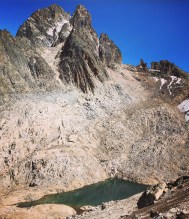Solastalgia: the grief of witnessing climate change
Former international school teacher Joe Human experiences solastalgia – the grief felt when witnessing the impact of climate change on something you love.
Kenya’s sacred mountain
In the ‘60s and early ‘70s we made Kenya our home. There we were married, had our family and put down deep roots. We loved the country, the ‘old country’, as we still call it. When we left we knew what it was to be homesick, achingly homesick. Had we stayed longer, we may never have left. There is still a large part of us which is Kenyan.

A view of Aberdare ranges in Nyandarua county in Kenya
For most of our time we lived on the compound of the school where I taught, on the lower slopes of the Aberdare Mountains. Our school faced Mount Kenya, whose glacier studded peaks, 30 miles away, gleamed in the early morning. To local people, Mount Kenya is sacred. In Kikuyu, it is known as Kirinyaga¸ the place where God lives. In a way it became sacred to us, part of our lives. The Mountain, we would say, have you seen the Mountain today?
Each year I climbed it, with friends and with students. For a young geographer, a still glaciated volcano, not long dormant, was God’s gift. We could reach the summit in three days, walk on the glaciers, scramble up the screes, fish in the streams, bathe in the tarns and sleep in the huts.
In time it became my Mountain, as Kenya became my Country.
For our eldest son, Richard, they became his, too. At 17 he returned for a year staying with friends. At 27 he returned for three more years to teach. And over the years went back again and again on photo-journalism assignments. On those returns he climbed the Mountain whenever he could.
Mount Kenya as it was and as it has become


At the end of 2019, now in his 50s, Richard went back yet again, with his eldest son, Archie, 12, to climb the Mountain. On return he sent me these two pictures, the first (on the left) from an archive, taken in 1971, and the second, his own, from almost the same spot. Looking at them, I feel a deep and unsettling disquiet, and a sense of profound personal loss at what human-made climate change has done … to our Mountain. The largest of the glaciers, Lewis, has melted away almost entirely. The smaller ones went long ago.
Now, not only do I know what it is to feel homesick, but also to experience profound ecological grief – ‘solastalgia,’ as it is now termed. The two share a kinship and a consequence and they are achingly personal.
 Joe Human
Joe Human
With 20 years teaching in Kenya , Papua New Guinea and England, 20 years working for Oxfam and another 15 Fairtrade campaigning, Joe has had a lifetime telling stories of people on the frontline. Now his time is spent communicating the realities of life for people on the frontline of climate change.
FEATURE IMAGE: by aroundtheworld.photography on iStock
Aerial view of simple farms and family homes in the Maasai tribal area in the Great Rift Valley, Kenya during the drought of 2022.
Support images : by Evans Mwaniki on iStock A view of Aberdare ranges in Nyandarua county in Kenya
Lewis Glacier – Mount Kenya: thank you to © Jens Kulbe – Mount Kenya 1971 & © Richard Human – Mount Kenya 2019
Further background about Kenya and climate change:

